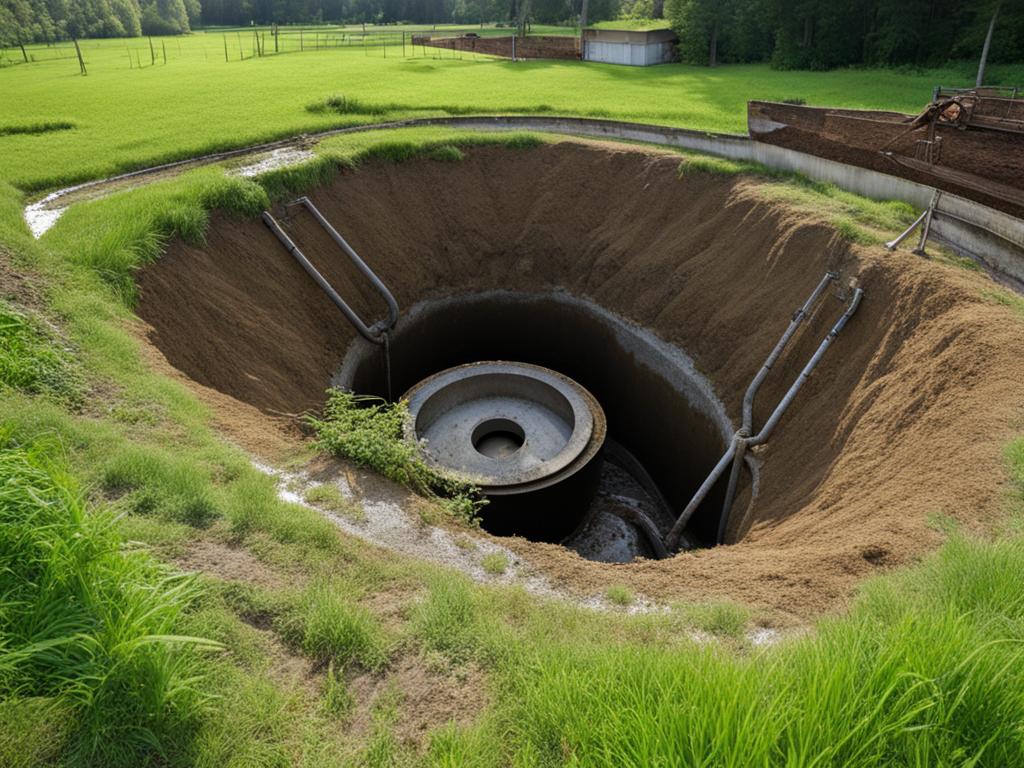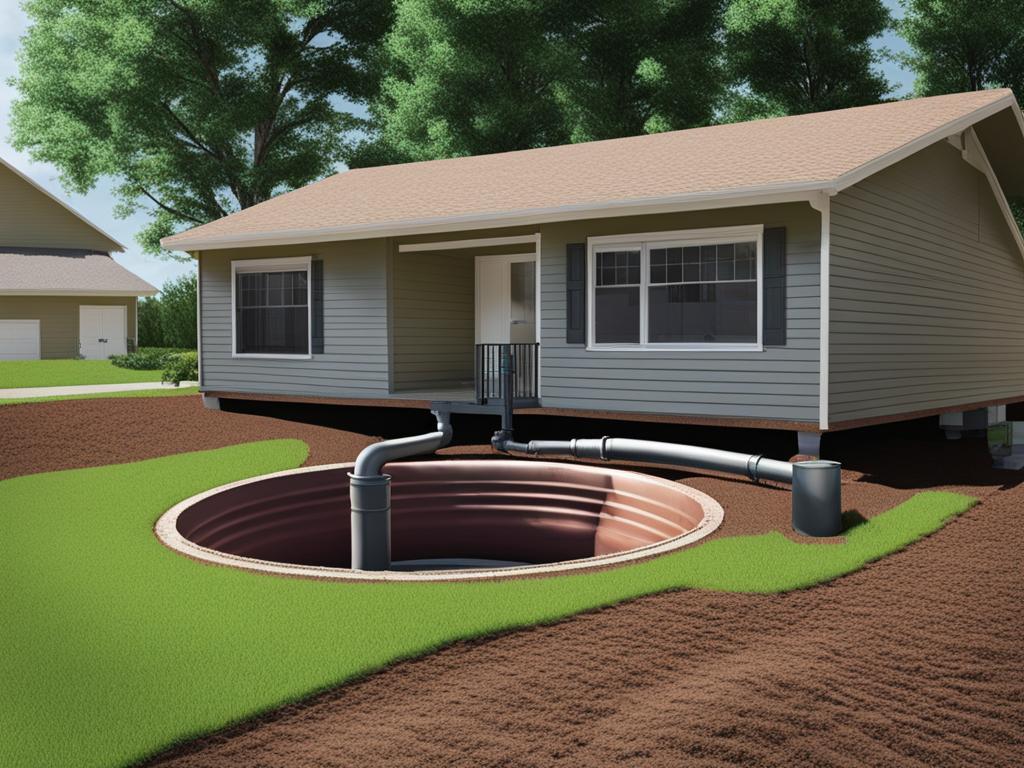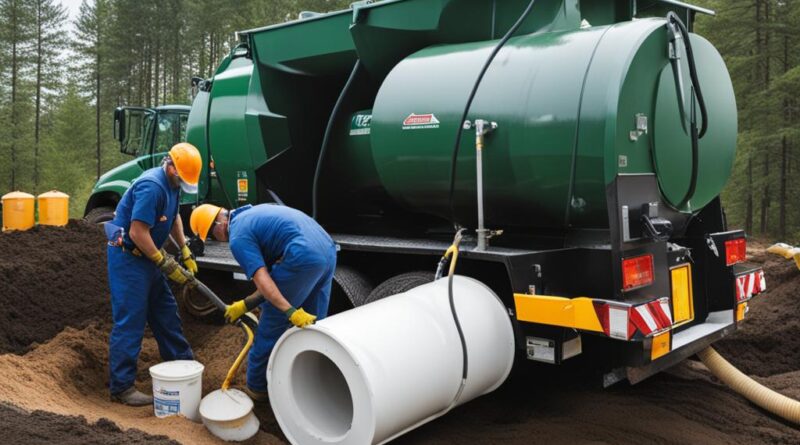Get the Lowdown: How Long Does it Take to Pump a Septic Tank?
When it comes to maintaining a septic system, one crucial aspect that homeowners need to be aware of is how long it takes to pump a septic tank. A septic system is a connected system of components that treat wastewater onsite, and proper maintenance is essential to ensure its optimal performance.
In this article, we will delve into the details of septic systems, the role of septic tanks in wastewater treatment, the function of the drain field, different types of septic systems, regular maintenance tips, and common problems to avoid. But first, let’s explore how long it actually takes to pump a septic tank and why it matters.
Key Takeaways:
- Septic tanks are an integral part of the septic system and play a crucial role in separating solid waste from effluent.
- The time it takes to pump a septic tank depends on the type of septic system and its specific components.
- Regular maintenance, including tank inspections and pumping, is necessary to prevent clogs and damage to the drain field.
- Avoid flushing chemicals or non-biodegradable items down the toilet to maintain the health and functionality of your septic system.
- Proper care and awareness will help homeowners maintain a healthy and functional septic system for years to come.
Unfamiliar with the Different Types of Septic Systems?
If you’re new to the world of septic systems, it’s important to understand the different types of systems available. Each type has its own unique features, advantages, and maintenance requirements. Let’s take a closer look at the various septic systems:
1. Conventional System:
The conventional septic system is the most common type found in residential areas. It consists of a septic tank, which separates solids from liquids, and a drain field, where the effluent is dispersed into the soil. This system is suitable for most homes and small businesses.
2. Chamber System:
The chamber system is often used in areas with high water tables. It features lightweight plastic chambers that provide additional storage capacity for effluent. These chambers allow for improved treatment and drainage, making it a suitable choice for areas with challenging soil conditions.
3. Aerobic Treatment System:
An aerobic treatment system injects oxygen into the wastewater, promoting the growth of beneficial bacteria that break down organic matter more efficiently. This system is ideal for sites with poor soil conditions or locations where a conventional system is not feasible.
4. Drip Distribution System:
A drip distribution system utilizes small, evenly spaced outlets to distribute effluent directly into the soil. This method helps to prevent clogging and can be an effective alternative to traditional drain fields.
5. Sand Filter System:
A sand filter system uses layers of sand and gravel to filter the wastewater before it enters the drain field. This type of system is commonly used in areas with high groundwater tables or poor soil conditions.
| System Type | Key Features | Advantages | Maintenance Requirements | |
|---|---|---|---|---|
| 1. | Conventional System | Septic tank, drain field | Cost-effective, widely used | Regular pumping, inspections |
| 2. | Chamber System | Plastic chambers, drain field | High water table suitability | Regular pumping, inspections |
| 3. | Aerobic Treatment System | Aerobic chamber, drain field | Enhanced treatment efficiency | Oxygen replenishment, maintenance of equipment |
| 4. | Drip Distribution System | Pipes with drip outlets, drain field | Clog prevention, efficient wastewater distribution | Regular maintenance of drip outlets |
| 5. | Sand Filter System | Sand and gravel layers, drain field | High groundwater suitability | Regular maintenance of sand filter |
These are just a few examples of the different types of septic systems available. It’s important to consider factors such as soil conditions, site limitations, and maintenance requirements when choosing the right system for your property. Consulting with a septic system professional can help you make an informed decision based on your specific needs and location.
“Understanding the different types of septic systems is crucial for homeowners and property owners. Each system has its own advantages and considerations, and choosing the right one can ensure efficient wastewater treatment and long-term system functionality.” – Septic System Expert
The Role of Septic Tanks in Wastewater Treatment
Septic tanks play a crucial role in the treatment of wastewater. As the first stop in the process, they separate solid waste from liquid waste, known as effluent. This solid waste includes heavy solids and greases that are trapped and retained in the tank, while the effluent is discharged into the drain field for further treatment and dispersal.
Septic tanks are designed to allow the separation of solids and liquids through a series of natural processes. The tank’s size and design can vary depending on the specific needs of the system. Common septic tank materials include concrete, plastic, and fiberglass, each offering durability and longevity.
Once the solid waste settles at the bottom of the septic tank, bacteria and other microorganisms break it down through a process called anaerobic digestion. This decomposition helps minimize the amount of solid waste that enters the drain field, preventing clogs and potential damage to the system. Regular pumping of the septic tank is essential to maintain its optimal functionality and prevent any issues.

Overall, septic tanks serve as the primary means of solid waste separation in wastewater treatment. By effectively removing and containing solid waste, they contribute to the overall efficiency and longevity of the septic system.
Understanding the Function of the Drain Field
The drain field, also known as the leach field, plays a crucial role in the septic system by filtering and removing contaminants from wastewater. It is essential to understand how the drain field works in order to ensure proper functioning of the septic system.
The drain field consists of a system of trenches filled with gravel and geo-fabric, along with perforated pipes that evenly distribute the wastewater. As the effluent flows through the drain field, the surrounding soil filters out harmful bacteria, viruses, and other contaminants. This natural filtration process helps to purify the wastewater before it reenters the groundwater.
Proper design and maintenance of the drain field are vital to prevent issues such as clogging and failure. The size of the drain field depends on factors such as soil type, water table level, and the volume of wastewater generated. It is important to ensure that the drain field is not overloaded with excessive wastewater, as this can cause system failure and environmental contamination.
Table: Comparing Different Types of Drain Fields
| Drain Field Type | Design | Functionality |
|---|---|---|
| Infiltration Trenches | Linear trenches filled with gravel and geo-fabric | Effluent is dispersed and filtered through the surrounding soil |
| Chamber Systems | Plastic chambers with perforated sidewalls | Effluent is evenly distributed and filtered through the chambers |
| Mound Systems | Raised mound of sand or gravel above the natural soil | Effluent is distributed over the mound and filtered through the soil layers |
“The drain field acts as the final treatment stage in the septic system, ensuring that the wastewater is purified before it returns to the environment. It is important to maintain the drain field by avoiding activities that could damage the system, such as parking vehicles or building structures on top of it.”
– Septic System Expert
Regular maintenance of the drain field is essential to ensure its optimal performance. This includes avoiding the use of harsh chemicals or non-biodegradable items that can harm the system and disrupt the natural filtration process. It is also recommended to have the drain field inspected periodically by a professional to identify any issues and take corrective measures before they escalate.
Different Types of Septic Systems and Their Pros and Cons
When it comes to septic systems, there are several different types to choose from, each with its own advantages and disadvantages. Understanding the differences between these systems can help you make an informed decision based on your specific needs and property requirements. Here’s a breakdown of the most common types of septic systems:
1. Conventional System:
A conventional septic system is the most basic and widely used type. It consists of a septic tank that collects and holds wastewater, allowing solids to settle to the bottom while the liquid effluent flows into the drain field for further treatment and absorption into the soil. This system is relatively low-cost and easy to maintain, making it a popular choice for residential properties. However, it requires ample space for the drain field and may not be suitable for properties with high water tables or poor soil conditions.
2. Chamber System:
A chamber septic system is a variation of the conventional system. It uses lightweight plastic chambers instead of traditional drain field pipes to disperse the effluent into the soil. This design provides a larger surface area for improved wastewater treatment and reduces the space required for the drain field. Chamber systems are generally more expensive than conventional systems, but they are ideal for properties with limited space or challenging soil conditions.
3. Aerobic Treatment System:
An aerobic treatment system introduces oxygen into the wastewater to facilitate the growth of aerobic bacteria, which are more effective at breaking down organic matter. This system requires an additional aerobic treatment unit, typically located after the septic tank. While aerobic treatment systems provide enhanced effluent quality and reduced drain field size, they are more complex and costly to install and maintain compared to conventional systems.
4. Drip Distribution System:
A drip distribution system, also known as a pressure distribution system, utilizes small-diameter tubing or emitters to evenly distribute effluent throughout the drain field. This system delivers a controlled amount of wastewater directly to the soil, promoting efficient treatment and preventing clogging. Drip distribution systems can be more expensive to install than conventional systems, but they are ideal for properties with limited space or challenging soil conditions.
5. Sand Filter System:
A sand filter system incorporates a layer of sand or other media between the septic tank and the drain field. The effluent is distributed over the sand filter, which acts as a physical and biological filtration barrier, removing contaminants before the wastewater reaches the drain field. Sand filter systems offer excellent treatment capabilities and are suitable for properties with poor soil conditions or limited space. However, they require regular maintenance and may be costlier to install compared to conventional systems.
6. Evapotranspiration System:
An evapotranspiration system, also known as a subsurface drip system or evapotranspiration bed, relies on vegetation and evaporation to treat and disperse wastewater. The effluent is distributed through a network of subsurface drip lines or sprayed onto specially designed beds with vegetation. Evapotranspiration systems are environmentally friendly and effective at treating wastewater, especially in areas with high water tables or poor soil conditions. However, they require regular monitoring and maintenance of the vegetation and may not be suitable for all property types.
7. Mound System:
A mound system is designed for properties with shallow soil depth, high water tables, or poor soil conditions. It consists of an elevated mound of sand or other suitable fill material that acts as a drain field. The effluent is distributed over the mound, allowing it to percolate and undergo treatment before reaching the groundwater. Mound systems are effective at treating wastewater in challenging site conditions but can be more expensive to install and maintain compared to conventional systems.

| Septic System Type | Pros | Cons |
|---|---|---|
| Conventional System | Low cost, easy maintenance | Requires ample space for drain field |
| Chamber System | Reduced drain field space requirements | Higher installation costs |
| Aerobic Treatment System | Enhanced effluent quality | Higher installation and maintenance costs |
| Drip Distribution System | Efficient wastewater treatment, suitable for limited space | Higher installation costs |
| Sand Filter System | Excellent treatment capabilities, suitable for poor soil conditions | Regular maintenance required |
| Evapotranspiration System | Environmentally friendly, effective treatment in challenging conditions | Regular vegetation maintenance |
| Mound System | Effective treatment in shallow soil or high water table areas | Higher installation and maintenance costs |
Regular Maintenance to Extend the Life of Your Septic System
Proper maintenance is essential to ensure the longevity and optimal performance of your septic system. By following a regular maintenance schedule, you can prevent clogs, damage to the drain field, and costly repairs. Here are some important maintenance tasks that you should prioritize:
Septic Tank Pumping
Regular septic tank pumping is crucial to remove accumulated solid waste and prevent it from overflowing into the drain field. The frequency of pumping depends on the size of your tank and the number of occupants in your home. As a general rule, septic tanks should be pumped every 3 to 5 years. However, for larger households or older systems, more frequent pumping may be necessary. Hiring a professional septic tank pumping service is recommended, as they have the expertise and equipment to safely and efficiently pump your tank.
Drain Field Maintenance
The drain field plays a vital role in filtering and dispersing the treated wastewater. To maintain its functionality, it is important to avoid heavy traffic or parking vehicles over the drain field area. Additionally, ensure that the drain field is free of trees, shrubs, and other vegetation that could interfere with the proper functioning of the system. Regular inspections of the drain field can help identify any issues, such as clogs or excessive water pooling, that may require professional attention.
Proper Waste Disposal
What you flush down the toilet or drain can have a significant impact on the health of your septic system. To avoid clogs and damage, it is important to dispose of waste properly. Only flush toilet paper and human waste, avoiding the use of paper towels, feminine hygiene products, flushable wipes, and other non-biodegradable items. Additionally, minimize the use of harsh chemicals, such as bleach and drain cleaners, as they can disrupt the balance of beneficial bacteria in the septic system.
| Maintenance Task | Frequency |
|---|---|
| Septic tank pumping | Every 3 to 5 years |
| Drain field inspection | Annually |
| Proper waste disposal | Ongoing |
By following these maintenance practices, you can ensure the longevity and functionality of your septic system. Regular inspections, pumping, and responsible waste disposal will help prevent problems and extend the life of your septic system, saving you time, money, and potential headaches in the long run.

How to Avoid Common Problems with Your Septic System
To avoid common septic system issues, it is important to be cautious about what you flush down the toilet. Certain items can cause clogs and backups, leading to costly repairs and potential damage to your septic system. Here are some key tips for septic system care:
- Do not flush sanitary products, such as tampons or pads, down the toilet. These items do not break down easily and can cause blockages in your septic system.
- Avoid flushing flushable wipes, as they do not disintegrate quickly and can accumulate in your septic tank, potentially causing clogs.
- Never flush paper towels down the toilet. Paper towels are thicker than toilet paper and can lead to blockages in your plumbing system.
- Do not dispose of coffee grounds down the sink or toilet. They can accumulate in your septic tank and cause clogs or hinder the natural breakdown of waste.
“Proper education and awareness can help homeowners prevent problems with their septic systems.”
By following these simple guidelines, you can help maintain the health and functionality of your septic system. Regular septic system inspections and maintenance also play a crucial role in identifying any potential issues before they become major problems. It is recommended to have your septic tank inspected annually and pumped every 3-5 years, depending on the size of your household and usage.
Remember, a little care and awareness go a long way in preserving the longevity of your septic system and avoiding unnecessary headaches and expenses.

Why Septic System Inspections are Crucial for Home Sellers
If you are planning to sell your home, it is important to prioritize the inspection of your septic system. Septic system inspections play a crucial role in ensuring the health and functionality of your septic system before putting your property on the market. Potential buyers often require a septic system inspection as part of the real estate transaction. By proactively addressing any issues with your septic system, you can avoid delays and complications during the selling process.
Having a thorough septic system inspection can provide peace of mind to both the seller and the buyer,” says John Smith, a real estate agent with over 10 years of experience. “It allows the seller to identify any potential problems and make necessary repairs, and it gives the buyer confidence in the condition of the septic system before making a significant investment.”
Regular inspections and maintenance are essential for maintaining the health of your septic system, regardless of whether you plan to sell your home. However, when selling a property, ensuring the functionality of the septic system becomes even more critical. A malfunctioning septic system can significantly impact the value and marketability of your home.
By conducting a septic system inspection, certified professionals can assess the overall condition of your septic tank, drain field, and related components. They will check for any signs of damage, leaks, or blockages that may require immediate attention. Additionally, they can provide valuable insights on the maintenance and care required to keep your septic system in optimal condition.
Investing in a septic system inspection not only benefits the home seller but also protects the interests of the buyer. It ensures that both parties have accurate information about the condition of the septic system, enabling them to make informed decisions throughout the real estate transaction process. By taking proactive steps to maintain your septic system, you can enhance the market value of your home and provide potential buyers with confidence in their purchase.

Benefits of a Septic System Inspection for Home Sellers:
- Identify and address any potential issues before selling your property
- Provide peace of mind to both sellers and buyers
- Maintain the value and marketability of your home
- Ensure accurate information for informed decision-making
In Conclusion
In conclusion, proper septic tank maintenance is crucial for the longevity and optimal performance of your septic system. Regular maintenance tasks such as tank inspections and pumping play a vital role in preventing costly repairs and ensuring the health of your septic system. By staying proactive and taking care of your septic system, you can avoid potential issues and maintain a healthy environment in and around your home.
Septic Tank Maintenance
Regular maintenance tasks for your septic tank include annual inspections and regular pumping. These activities help remove accumulated solids and prevent clogs, which can lead to system failure. Working with a professional septic tank service provider ensures that your tank is properly maintained and kept in good condition. Remember, neglecting septic tank maintenance can result in costly repairs and potential health hazards.
Septic System Longevity
The longevity of your septic system depends on various factors, including proper maintenance, usage habits, and the type of septic system you have installed. By following recommended maintenance practices and being mindful of what goes into your septic system, you can extend its lifespan. Regular inspections, pumping, and responsible usage will keep your septic system functioning efficiently for many years to come.
Septic System Care
Caring for your septic system involves more than just regular maintenance. It also includes being mindful of what you flush down your toilets and drains. Avoiding the disposal of non-biodegradable items, chemicals, and excessive amounts of oil and grease is essential to prevent system clogs and damage. By adopting responsible usage habits and educating your household members, you can contribute to the long-term care and health of your septic system.
FAQ
How long does it take to pump a septic tank?
The time it takes to pump a septic tank can vary depending on the type of septic system and its specific components. It is recommended to have your septic tank inspected annually and pumped every 6 months to prevent clogs and damage to the drain field.
What are the different types of septic systems?
There are several types of septic systems, including conventional, chamber, aerobic treatment, drip distribution, sand filter, evapotranspiration, and mound systems. Each system has its own unique method of treating and dispersing wastewater.
What is the role of septic tanks in wastewater treatment?
Septic tanks are the first stop in the wastewater treatment process. They separate solid waste, such as heavy solids and greases, from the liquid waste, known as effluent. The effluent is then discharged into the drain field for further treatment and dispersal.
What is the function of the drain field?
The drain field is an important part of the septic system that filters and removes contaminants from wastewater. It consists of a system of trenches filled with gravel and geo-fabric, along with perforated pipes that disperse the wastewater.
What are the pros and cons of different types of septic systems?
Each type of septic system has its own advantages and disadvantages. Conventional systems are common in single-family homes and small businesses, while chamber systems are used in areas with high water tables. Aerobic treatment systems infuse oxygen into wastewater for efficient treatment, and drip distribution systems eliminate the need for traditional drain fields. Sand filter systems, evapotranspiration systems, and mound systems have their own unique characteristics and maintenance requirements.
How can I extend the life of my septic system?
Regular maintenance is crucial to extend the life of your septic system. This includes annual inspections, pumping the septic tank every 6 months, and proper care of the drain field. Regular maintenance will help prevent clogs and damage to the drain field, ensuring the optimal performance of your septic system.
How can I avoid common problems with my septic system?
To avoid common septic system issues, it is important to be cautious about what you flush down the toilet. Items such as sanitary products, flushable wipes, paper towels, and coffee grounds can cause clogs and backups. Avoid flushing chemicals, as they can harm the septic system and the environment. Proper education and awareness can help homeowners prevent problems with their septic systems.
Why are septic system inspections crucial for home sellers?
If you are planning to sell your home, it is important to have your septic system inspected. Inspections can identify any issues with the septic system that need to be addressed before selling the property. Potential buyers may require a septic system inspection as part of the real estate transaction. Regular inspections and maintenance can help ensure the health and functionality of your septic system.
How can I maintain the longevity of my septic system?
Regular septic tank maintenance, including inspections and pumping, is essential for extending the life of your septic system. By following proper care and maintenance guidelines, you can ensure a healthy and functional septic system for years to come.

